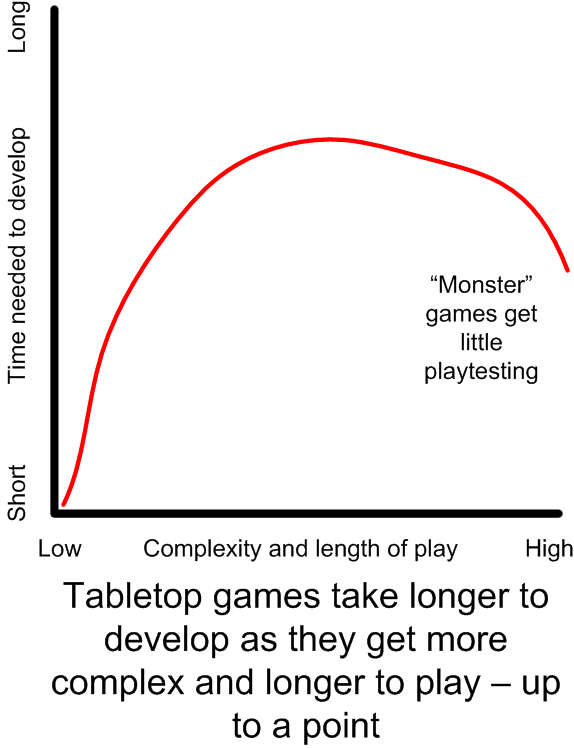Some time ago I was designing a couple games that are so small you couldn't even call them microgames. Maybe nano-games would do? At the World Boardgaming Championships in early August I saw yet again the postcard-size wargames that "Against the Odds" magazine gives away as promotional materials. The entire game is on the postcard, board on one side, rules on the other side, 17 to 20 half inch pieces printed along the edge.
As I've said many times before, I think that restrictions and constraints help one actually create better work. Beethoven benefited from the rules of classical music even as he sometimes broke those rules. Modern painting is so god-awful, at least in my opinion, because there are no rules. If you give a novice game designer carte blanche to design whatever they want they often flail around and then try to do something completely impractical. A postcard size game, on the other hand, introduces tremendous constraints.
As my favorite game is the game of designing games, this was an interesting project to attempt. Having worked up two of them and played one with the other about to be played, I can say that this format requires you to decide what is the essence you want people to learn from the game. These are not games that people are going to play over and over again because there is so little there. So when they play I want them to understand the essence of the historical situation, what was really important. And that can be done even in this small format, although there is no room for the designer to then explain the reasoning behind his choices.
For example, the first game is about the raids of the "Great Heathen Army" on Frankia in the late ninth century, after they’d been stymied by Alfred the Great in Britain. It is a solitaire game with the player trying to defend Frankia from randomly determined attacking Vikings. The player does not know the strengths of either the Vikings or his own troops. He doesn't know the strength of the Vikings because it was so hard to collect and then communicate information in that era, and the Vikings could move by boat much, much faster than the Franks could move on land. He doesn't know the strength of his own troops because both raising those troops and getting them to fight was so unreliable. (At this point the Franks actually had a capable king, which was exceptional.) The Vikings are especially likely to go upriver, and that's reflected in the dice rolls to determine their actions.
I have doubts that I'll be able to get all the rules into a format of about 600 words, we'll see.
The second game is the First Battle of Savo Island, during the American invasion of Guadalcanal. The Japanese were immensely better at night fighting than the Americans, aided by having immensely better torpedoes (and lots of torpedoes on their cruisers, which the Americans either didn't have or didn’t use). The American guarding force got crushed but the Japanese turned away rather than tear into the American transport fleet. So the game needs to reflect those spotting limitations and the difference in torpedoes. And once again I use the uncertainty of face down pieces to try to represent the confusion of night fighting.
When you have so few pieces you must make them do double-duty. Either they must have “steps,” so that you can turn the piece over when hit to show the weaker side, or they must simulate "fog of war" to provide uncertainty, so players see only the blank side of the opposition much of the time. In the Viking game some of the pieces are "0's", which are decoys on the Viking side, failures of recruitment and leadership on the Frankish side, but this is not revealed until there's a battle. There are a few decoys in Savo, too, but also a non-decoy piece can be as weak as a couple destroyers or as strong as a couple heavy cruisers.
Nano-games tend to be tactical rather than strategic - though I have to say my Viking game is more strategic than tactical. The board and piece limitations don’t provide much room for the flexibility of a game with economic production, which is often a component of strategic games.
 A virtue of designing "nano-games" is that they take less time to create and to balance. The accompanying diagram reflects this notion. Notice at the end, the "monster tabletop games" of a thousand pieces and enormous boards, the time goes down. That's because such games are bought more for the information than to actually play, and are rarely playtested more than a few times during design. Playtesting, of course, takes up most of the time in designing almost any game.
A virtue of designing "nano-games" is that they take less time to create and to balance. The accompanying diagram reflects this notion. Notice at the end, the "monster tabletop games" of a thousand pieces and enormous boards, the time goes down. That's because such games are bought more for the information than to actually play, and are rarely playtested more than a few times during design. Playtesting, of course, takes up most of the time in designing almost any game.(Most of my blog hosts don’t handle diagrams well, so you may need to go to http://pulsiphergames.com/images/XY_length_development.gif
to see this diagram.)












No comments:
Post a Comment